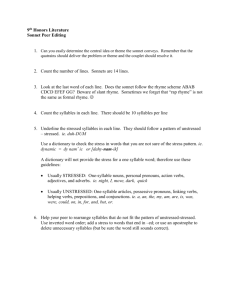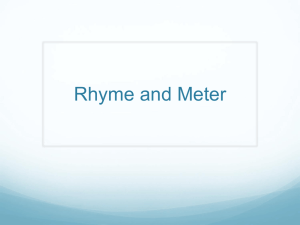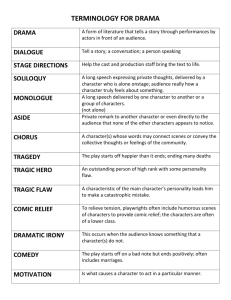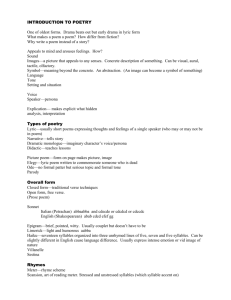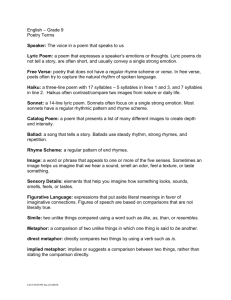The Snappy Guide to Scanning a Poem
advertisement
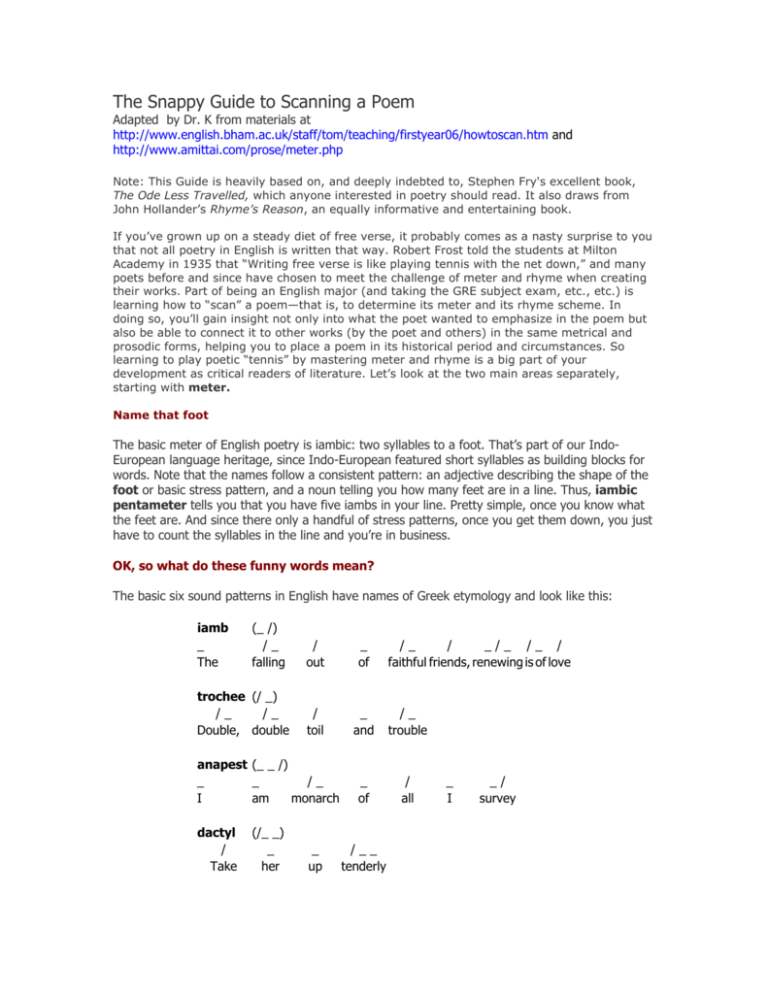
The Snappy Guide to Scanning a Poem Adapted by Dr. K from materials at http://www.english.bham.ac.uk/staff/tom/teaching/firstyear06/howtoscan.htm and http://www.amittai.com/prose/meter.php Note: This Guide is heavily based on, and deeply indebted to, Stephen Fry's excellent book, The Ode Less Travelled, which anyone interested in poetry should read. It also draws from John Hollander’s Rhyme’s Reason, an equally informative and entertaining book. If you’ve grown up on a steady diet of free verse, it probably comes as a nasty surprise to you that not all poetry in English is written that way. Robert Frost told the students at Milton Academy in 1935 that “Writing free verse is like playing tennis with the net down,” and many poets before and since have chosen to meet the challenge of meter and rhyme when creating their works. Part of being an English major (and taking the GRE subject exam, etc., etc.) is learning how to “scan” a poem—that is, to determine its meter and its rhyme scheme. In doing so, you’ll gain insight not only into what the poet wanted to emphasize in the poem but also be able to connect it to other works (by the poet and others) in the same metrical and prosodic forms, helping you to place a poem in its historical period and circumstances. So learning to play poetic “tennis” by mastering meter and rhyme is a big part of your development as critical readers of literature. Let’s look at the two main areas separately, starting with meter. Name that foot The basic meter of English poetry is iambic: two syllables to a foot. That’s part of our IndoEuropean language heritage, since Indo-European featured short syllables as building blocks for words. Note that the names follow a consistent pattern: an adjective describing the shape of the foot or basic stress pattern, and a noun telling you how many feet are in a line. Thus, iambic pentameter tells you that you have five iambs in your line. Pretty simple, once you know what the feet are. And since there only a handful of stress patterns, once you get them down, you just have to count the syllables in the line and you’re in business. OK, so what do these funny words mean? The basic six sound patterns in English have names of Greek etymology and look like this: iamb _ The (_ /) /_ falling trochee (/ _) /_ /_ Double, double / out _ of / toil _ and /_ trouble _ of / all anapest (_ _ /) _ _ /_ I am monarch dactyl / Take (/_ _) _ her _ up /__ tenderly /_ / _/_ /_ / faithful friends, renewing is of love _ I _/ survey 2 spondee (/ /) pyrrhic (_ _) / / and the white breast - of the / dim / sea The names of the line lengths are easy, too. There’s a prefix that tells you how many feet, and the root word is always “meter.” monometer dimeter trimeter tetrameter one foot two feet three feet four feet pentameter hexameter heptameter octameter five feet six feet seven feet eight feet It’s probably going to be iambic The vast majority of poems that you will come across are in meters of iambic pentameter (five feet, ten syllables) or iambic tetrameter (four feet, eight syllables). Three syllable feet do occur, but they are rare, and usually used for special effect: comedy, or onomatopoeia (where the sound of the poetry imitates the subject of the poem). More about them below. So, the first thing to do is to read the poem to yourself, either out loud or in your head. If it is based on three syllable feet, you'll notice it. If not, then it is almost certainly iambic. If it is, mark up the line with a pencil, putting in a vertical line after every two syllables. The woods | decay | the woods | decay | and fall when you | are old | and grey | and full | of sleep If you can't make it fit to a two-syllable pattern, check the expansion/contraction rules (below). If you still can't, check the trisyllabic feet below. (If you’re working on computer, you can either capitalize the STRESSED syllables or change the color of the font—whatever works for you.) When you've sorted out the feet, read the poem again for the sound. Emphasize the stressed syllables the way you would in normal conversation, not with any “funny” or “literary” effect. The WOODS | deCAY | the WOODS | deCAY | and FALL when YOU | are OLD | and GREY | and FULL | of SLEEP How do you know which are stressed and which are unstressed? Stressed words are important words like nouns and verbs (after that, adjectives and adverbs), unstressed are unimportant words and sounds (prefixes, suffixes, prepositions, particles). Stressed syllables are those that you will recognize as stressed because you are a native speaker: no one would say DEcay, for instance. Mark the stressed syllables above the words with a diagonal line/ and the unstressed with a horizontal line —. You will find that the majority of feet are unstressed syllables preceding stressed ones, like this: the WOODS. That is an iamb; the meter therefore is iambic. 3 But what if the poet cheats and changes some of the feet? Poets will do that. If poetry were just a machine that churned out foot after foot of the same rhythm, there would be a Google tool that did it for you mechanically. What changes mechanical, sing-song verse into poetry is how the poet uses occasional variation in the meter to subtly emphasize the meaning of the poem. This is what makes the poem interesting and not just a sing-song chant (though a good poet can get wonderful effects from a sing-song chant). There are three possible kinds of substitution. Instead of unstressed/stressed (iambic), you can have 1. stressed/unstressed. This is a trochee, and is therefore trochaic substitution. 2. stressed/stressed. This is a spondee, and is therefore spondaic substitution. 3. unstressed/unstressed. This is a pyrrhus, and therefore pyrrhic substitution. Here are some examples, to show how the substitutions (in a good poet) enhance the meaning: Trochaic substitution Far from the madding crowd's ignoble strife FAR from | the MAD | ding CROWD'S | ignOB | le STRIFE Trochaic substitution in the first foot to emphasize distance My heart aches, and a drowsy numbness pains My HEART | ACHES and | a DROW | sy NUMB | ness PAINS Trochaic substitution in the second foot to emphasise the ache: the pain Spondaic substitution On BOTH | SIDES THUS | is SIM | ple TRUTH | supPRESS'D Spondaic substitution in the second foot to show how the world contradicts itself (the whole of Shakespeare’s Sonnet 138 is intricately patterned around the theme of lies and contradictions). Pyrrhic substitution Shall I compare thee to a summer's day? SHALL i | comPARE | thee to | a SUM| mer's DAY? Trochaic substitution in the first foot to emphasise wondering. But also pyrrhic substitution in the third foot, like a pause as he thinks of something amazing to compare her with. And finds it. You could read the first foot as a iamb, but the trochaic stress seems better (to me, at any rate). This is not rocket science: you get choices. Not in the hands of boys, but in their eyes Shall shine the holy glimmers of goodbyes NOT in | the HANDS | of BOYS, | but in | their EYES This is Wilfred Owen, on the horror of the First World War, where young men—boys— were slaughtered in hundreds of thousands. Trochaic substitution in the first foot to emphasise NOT; pyrrhic substitution in the fourth foot, to give a build-up to the image of the eyes of all these dead young men. Shall SHINE | the HOL | y GLIM | mers of | goodBYES Repetition of the pyrrhic substitution in the fourth foot, to give a pattern: the goodbyes are in their EYES. Also, to give a pause—wait for it—before the tragic final two syllables of the line. You can find the whole of this fantastic poem here. 4 So, when you analyze a poem, what you need to do is to find all the substitutions and comment on them. In a good poet, there will be a reason for every one, and the reason will be to do with the meaning of the poem. Line endings Next, look at the line endings. How do they affect the meaning? The lines will either be endstopped (the line ends with a natural break in the sense, often emphasized by punctuation): Shall I compare thee to a summer's day? Thou art more lovely and more temperate. Or else the line will run on: And sometime like a gleaner thou dost keep Steady thy laden head across a brook This is called enjambment and is often used for poetic effect, as here; the line end, plus the trochaic substitution in the first foot of the second line, give you the balancing act that she must do as she crosses the brook. John Donne was a master of enjambment: On a huge hill, Cragged and steep, Truth stands, and he that will Reach her, about must and about must go, And what the hill's suddenness resists, win so. (Note the emphasis on -ed in | CRAGged |). The poem imitates the action and effort (will/REACH) of climbing the hill in search for truth. In the last line, the trochaic substitution in the third foot, plus the elision or running-together of the middle syllable of that foot (SUDd'nness), plus the awkward s sounds give the effort and difficulty of the climb; the spondaic substitution in the last foot gives a sense of release and success. Brilliant. And WHAT | the HILL'S | SUDd'nness | reSISTS | WIN SO Despite what your first-grade teacher taught you about stopping and taking a breath at the end of each line of poetry so that all the other first graders could hear the rhymes, when a line is enjambed, you should read it that way, so that your audience hears the energy and motion of that wraparound syntax. You can give a slight pause at the line’s end, but don’t read enjambed lines in that sing-song “Mary Had A Little Lamb” way if you’re a grownup student of literature. Save it for “reading to the class” day at your child’s elementary school. The Caesura Most lines of poetry have a natural pause, usually in the middle. This is the caesura. Not in the hands of boys, || but in their eyes This can be used to reinforce the meaning: And what the hill's suddenness resists || win so. 5 That's a delayed caesura before the last foot, reinforcing the feeling of triumph and attainment in—wait for it—WIN SO. So, in each line of a poem, look for the caesura, and see what sort of work it's doing. The eleven-syllable iambic pentameter line Poets aren’t necessarily good at math, but sometimes they miscount for a reason. Occasionally you’ll find a line that feels like iambic pentameter but has eleven syllables. called a hendecasyllable. It's because though most English words end with a stressed syllable, many don't, and poets didn't want to deny themselves the possibility of ending a line with one of them, such as 'tomorrow' or 'question'. Do these sound familiar? To BE | or NOT | to BE || THAT is | the QUES | tion 11 syllables, with a trochaic reversal after the caesura: Hamlet is very puzzled, and fears death. ToMORR | ow and | ToMORR | ow and | ToMORR | ow Hendecasyllablic with no less than two pyrrhic substitutions. Because so many syllables are unstressed, the stressed syllable sounds like the crack of doom: bang—wait for it—Bang—wait for it—BANG. Two of the greatest lines in the whole of English. For that, you can learn to live with a long mysterious sounding Greek word: hendecasyllabic. The same goes for a line famous in American pop culture: To BOLD | ly GO | where | no MAN | has GONE | BE fore The hendecasyllabic intrusion in the middle of the line makes you wait for the result of that bold going—and then that trochaic (or some would say spondaic) ending just punches the meaning home. That’s why the line is so memorable—the rhythms just engrave it on your ears. Expansion/contraction rules a. Words ending in -er or -en (e.g., ever, never, or heaven, given) are often treated as one syllable: "heav'n." In older texts they are sometimes spelled that way, too. b. When a word ends with -ed the ed can be pronounced as a separate syllable: naked; or not: passed. Sometimes it's optional: winged can be said with two syllables, or one (wing'd). Poets exploit that possibility to add or lose a syllable. Watch out for it. c. When two vowels are next to each other, they can often be scanned either as two syllables or one (offbeat) syllable, depending on what the poet needs for the meter. In words that have a u before another vowel, it may be treated like a w: unusual, "un-Uzhwal" (3 syllables) or "un-U-zhu-AL" (4 syllables). I may be treated as a y: proverbial: "pro-VERB-yal" or "pro-VERB-i-AL." You can detect this by simply relying on your instinct as a native speaker of English. d. When you have an unaccented vowel ending one word and another one beginning the next word you can elide (it means slur, or run) them together. This is called elision. The expense of spirit in a waste of shame is spoken as 6 Th'expense of spirit in a waste of shame e. The endings -tion and -sion may be scanned as one syllable (as today) or as two, with secondary stress on the -on. Our two souls therefore, which are one, Though I must go, endure not yet A breach, but an expansion, Like gold to aery thinness beat. A BREACH || but an | exPAN | si-on After the caesura, the two pyrrhic substitutions surround the iambic foot so that the emphasis exPANDS to compensate. Don't be intimidated by this. It's not difficult, and mostly you can get it by instinct. Practice out loud while you’re working with that pencil—the worst that can happen is that people around you will hear some good poetry instead of the blather of people chatting on their cell phones. But what if it's not iambic? Well, it's either going to be trochaic, or dactyllic, or anapaestic. But these strange meters will always signal themselves clearly, and either be used for comic effect, or for sound effect. You can hardly not notice them, or mistake them. And they really are rare. Trochaic (STRESSED unstressed) You could trace them through the valley, By the rushing in the Spring-time, By the alders in the Summer, By the white fog in the Autumn, By the black line in the Winter; YOU could | TRACE them | THROUGH the | VALLey, BY the | RUSHing | IN the | SPRING-time and so on, and on. This is Longfellow's Hiawatha. It's very monotonous. Very hard to think of another example of pure trochaic, with good reason: the English language doesn't like it. three styllable (trimeter): Dactyllic STRESSED unstressed unstressed. Cannon to right of them Cannon to left of them Cannon in front of them Volleyed and thundered. CANNon to | RIGHT of them CANNon to | LEFT of them CANNon in | FRONT of them VOLLeyed and | THUNdered. 7 It's about a cavalry charge. Horses galloping. The verse gallops too. three styllable (trimeter): Anapaestic Unstressed unstressed STRESSED I sprang to the stirrup, and Joris, and he; I galloped, Dirck galloped, we galloped all three; I SPRANG | to the STIRR | up, and JOR | is, and HE; I GALL | oped, Dirck GALL | oped, we GALL | oped all THREE; More galloping. The problem is, you can't do too much of this, or it gets really tedious. That's why the poet has placed an iambic substitution in the first foot. Apart from that, it's all galloping. You don't really have to worry about these. When they occur, they are obvious, and easy to scan. And they very rarely happen. More worrying is Mixed meter Towards the end of the nineteenth century, and into the beginning of the twentieth, poets began to feel that the rule book was pretty much of a hindrance; that all the good stuff had been done in the usual forms. So, they started getting creative with the rule book. When this happens in a poem, it's obvious when you read it that something is going on, because the meter is so strange; but scanning it is difficult. However, don't worry: it is so difficult that no-one will mind if you get bits of it wrong. We won’t even go into Gerard Manly Hopkins’ sprung rhythm here; if you must know, buy Dr. Naufftus or Dr. Brownson a cup of coffee and ask them to explain it to you. What about rhyme schemes? Rhyme is the repetition of similar sounds in comparable syllables of different words. In standard rhyme in English, the initial consonant (or initial consonant group) of rhyming syllables is not repeated, but the rest of the syllable is repeated — the vowel, and any closing consonant or consonants, if present. Standard rhyming matches the vowel of the last stressed syllable of rhyming words, and any sounds following the vowel, including any unstressed syllables coming after that last stressed syllable. Thus folk rhymes with poke; allow rhymes with plow; hollow rhymes with follow; and writing rhymes with exciting. Exciting does not rhyme with thing, however, since the -ing in exciting is not stressed. Any rhyme with exciting must repeat the entire sound following the initial consonant of the last stressed syllable, here soft c, and thus must end in -iting. Rhymes consisting of stressed final syllables alone are called masculine rhymes, such as approach/coach; rhymes including an unstressed syllable after the stressed one are called feminine: Apollo/swallow. Rhyme is determined by sound, not spelling, so don’t get fooled. Which of these two pair of words rhyme? puff / enough through / though Standard rhymes are perfect rhymes, in which the vowel of the last stressed syllable and all following sounds are repeated exactly. Some poetry uses near rhymes, also called slant rhymes or imperfect rhymes. These may make use of assonance, which is the repetition of the vowel but with different consonants following it, or consonance, which is the repetition of 8 the consonant or consonants following the vowel but the use of different vowels, or a combination of the two, using either vowels or consonants that are similar but not the same. Rhyme variation often happens in hip-hop lyrics, often with comic effect, as in Eminem’s Lose Yourself: Yo, His palms are sweaty, knees weak, arms are heavy There's vomit on his sweater already, mom's spaghetti He's nervous, but on the surface he looks calm and ready To drop bombs, but he keeps on forgetting What he wrote down, the whole crowd grows so loud He opens his mouth, but the words won't come out The vowel sounds in sweaty, heavy, sweater, already, spaghetti and ready all assonate, so they are near rhymes, as are down, crowd, loud, mouth, and out. Part of Eminem’s skill in this composition is the way he strings both internal and final rhymes together to unify the lines. Different periods and dialects of English may make certain rhymes possible that do not seem evident in contemporary Modern Standard English. All of these rhymes reflect pronunciations in which the sounds actually do rhyme, or form near rhymes. A few examples in Early Modern English poetry, including Shakespeare, are: • Words ending in -y (or -ly, etc.) rhyme with words like die and eye: memory/die; • • • Words ending in unaccented -a rhyme with words like day: Julia/day. Words having the oi diphthong rhyme with words with a long i: boil/style. Do and go often rhyme, perhaps as a close o sound intermediate between "oh" and "oo," something like the sound of the o in Minnesota as pronounced by some Minnesotans. Likewise, done sometimes rhymes with gone. Somewhat similarly, love often rhymes with move and prove — perhaps the vowel in all of them was about the same as now the vowel in foot — a pronunciation still current for these words in some areas of Northern England and Scotland. In Scottish texts such as ballads, words ending in -ie may rhyme with words ending in ee: die/see. • • symmetry/eye. Likewise, other words may be syllabified differently in Early Modern English, in ways that affect rhyme. In Shakespeare's Sonnet 18, temperate takes three syllables ("TEM-puh-rate," rather than "TEMP-ruht") and rhymes with date. In Anne Bradstreet's poetry, safety takes three syllables ("SAFE-uh-tee" or "SAFE-uh-tie") and rhymes in ways that apply to other -y endings. Difference is sometimes pronounced as three syllables and rhymes with words like fence hence, as it does in a modern poem, Robert Frost's "The Road Not Taken." So why does rhyme matter? Because when poets put patterns of rhyme together, they give shape and emphasis to the meaning of the poem. These patterns of rhyme are called rhyme schemes. We usually describe them by using letters to indicate which lines rhyme. For example abab indicates a four-line stanza in which the first and third lines rhyme, as do the second and fourth. Here is an example of this rhyme scheme from To Anthea, Who May Command Him Any Thing by Robert Herrick: Bid me to weep, and I will weep, While I have eyes to see; And having none, yet I will keep 9 A heart to weep for thee. Sounds in orange are marked with the letter A Sounds in purple are marked with the letter B So the rhyme scheme of this stanza is ABAB. Some rhyme schemes are so consistent that literary critics have given special names to them; this is particularly true of sonnets. An Italian or Petrarchan sonnet will rhyme lines of iambic pentameter using five sounds in the pattern abba abba with a sestet of cde cde in some variation (there are lots of possibilities). An English or Shakespearean sonnet will rhyme iambic pentameter lines using seven sounds in the pattern abab cdcd efef gg. A Spenserian (or masochistic) sonnet will rhyme iambic pentameter lines using five sounds in the pattern abab bcbc cdcd ee. Tennyson’s In Memoriam stanza was rhymed lines of iambic tetrameter in the pattern abba. Learn the basics, and before you know it you’ll be tossing off clerihews, ottava rima, rondelets, and sestinas with lavish abandon. If you want some practice, try the examples on this web page: http://www.curriki.org/xwiki/bin/view/Coll_rmlucas/PoetryRhymeSchemePractice. When determining a rhyme scheme, remember that the pronunciation of words has changed greatly over the years. Give some thought to how a word might have sounded before you decide "That doesn't rhyme" and throw the book down in disgust! Word meanings have changed, too, and the Oxford English Dictionary is the best place to look up words and figure out what they meant at the time a particular author was writing. And if you’re working with Emily Dickinson, who was inspired by the many hymn meters of her time, remember that she counts syllables and not feet—but that’s matter for a different Snappy Guide.
